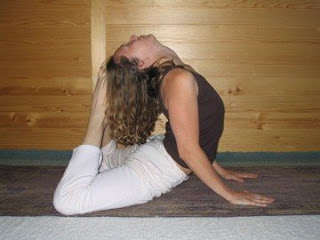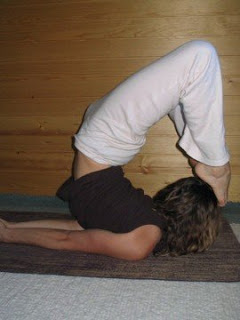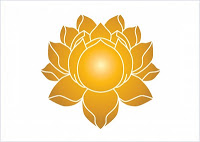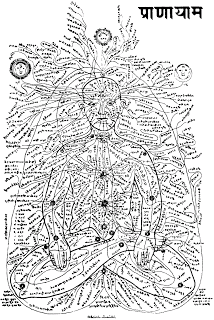10 amazing benefits of a regular yoga practice.
Asanas are the physical position, or postures, of yoga. Asana is a Sanskrit word.
Sanskrit is known as the language of the Gods. It is ancient, subtle, and complex.
The word asana means seat, or position: literally, the relationship that your body has to the earth. Sanskrit being Sanskrit, there is also an implied meaning: steadiness, and comfort.
So asana is a position that is held steady and comfortable.
 |
| Petra in King Cobra; Poorna Bhujangasana |
What happens when you practice these positions in the right way (holding them steady, and relaxing into them) is that you (1) breathe deeply. Since any time you remain steady and relax deeply, your breathing will also deepen as a natural consequence.
As your body lets go of unnecessary tension (which is absolutely inevitable with practice, because it’s simply not possible to hold an asana whilst also holding on to stress) there is a deep (2) ‘letting go’. Emotional stress that was locked away in the muscles and tissues of the body, especially the fascia, dissolves. This is why people sometimes cry or feel emotional during yoga practice; usually however the ‘letting go’ is on a more subconscious level.
As the body breathes more and more deeply, the lungs expand and contract more fully, gently and rhythmically (3) massaging the internal organs and glands. They are toned; toxins are released; and all the systems in the body – the endocrine system (hormones); nervous system (stress + relaxation); circulatory system (energy) digestive system, and metabolism – are balanced.
As well as this internal massage, the yoga postures are also well known for the wonderful (4) external massage that they give: stretching. The muscular skeletal system is rebalanced completely; the main reason why yoga is known to be quite simply the best remedy for a bad back. Problems with alignment are corrected automatically, as the body remembers it’s proper relationship with all it’s various parts.
Another reason why yoga helps to fix a bad back, apart from the stretching aspect of the exercises, is that it (5) strengthens the body, especially the core of the body. The core muscle groups are the ones that hold the body internally, maintaining good posture and balance. Look at an experienced yoga asana practitioner, and you’ll see physical poise, balance, and lightness of limb. Yoga is known as ‘skill in action’, and certainly physical mastery is one of the results.
Inverted postures (such as shoulderstand and headstand) reverse the effect of gravity on the blood flow in the body, bringing (6) much needed nutrition and energy to parts of the body that may lack them, rejuvenating the upper regions – heart, throat, and brain.
The heart is especially benefited by these inverted postures due to the effect known as ‘Starling’s Law’, which states that the more the heart muscle stretches, the more it in turn contracts. The large volume of blood entering the heart (carried freely by gravity from the legs, pelvis, and abdomen) stretches it greatly so that it then contracts strongly, and is given wonderful exercise; without any stress on the nervous system and knees, which other more aerobic cardiovascular exercise is guilty of.
Heart disease, formerly thought to be irreversible, has been demonstrated to be not only reversible but also cure-able with the help of yoga.
I mentioned hormones above. Most people don’t realize how important the endocrine system (system of glands which produce hormones to regulate many of the functions of our organism) is: it is responsible for our moods. That’s why we sometimes put unpredictable behavior down to someone being ‘hormonal’!
In short, when you practice yoga, the endocrine system is balanced, toned, and stimulated, so that (7) the correct levels of specific hormones are produced: to dissipate stress, and induce relaxation.
I don’t mind telling you that before I became a yoga teacher many years ago, I was a party animal, living a fairly hedonistic lifestyle in London.
One of the things that ‘hooked’ me to yoga was that I realized the wonderful feelings and experiences I had using recreational drugs then, could be reproduced without the drugs.
To be specific: I attended a wonderful yoga class, and left the class one Autumnal evening feeling as if I had taken MDMA (ecstasy). My vision was sharp; my body felt as light as a feather; my thoughts were ‘crystal clear’; and my mood was one of calm, ecstatic, joy bubbling up and over me… in short, exactly the same experience I had had ‘partying’. As I walked home that evening through the streets of London, the streetlamps seemed as beautiful as the trees. The air I breathed was like nectar, and each person hurrying past was a being towards whom I felt infinite compassion. In one word: I was pure love. The next day there was no ‘come-down’; I knew I could tap into that feeling anytime I wanted, because the source of it was not something external – a drug – but something inside of me. My love affair with yoga continued on from there… and one of the reasons I teach it is that I want to share that incredible internal experience with others.
Yoga also brings our attention to any issues that we have – physical and emotional. It’s very hard to do a full yoga class and not notice tension in the body, or anger in the heart. The nature of these postures is that they (8) bring problems, weaknesses, and stress to our attention. By way of example: if you have a weakness in your knee, which may well go unnoticed until you run for the bus and damage the joint, practicing yoga will undoubtedly bring the problem to your attention. You will then have to adapt your practice to accommodate the injury, and soon you will find that the problem is gone, as the postures soothe, stretch, and strengthen the ligaments, muscles, tendons, and tissues around the problem.
 |
| Locust / Shalabhasana; don’t try this at home! |
Finally, practicing the physical aspects of yoga brings clarity, focus, and balance to the mind. Asana practice is really meditation too. It brings us mindfully into the present moment, with ease and grace, so that (9) magic happnens: our body and mind integrate again. While most people think of themselves as a mind and a body; or perhaps a mind in a body; the truth is that the mind and body are one. There really is no separation between the two: they are like two sides of the same coin.
The reality is that human beings are pure consciousness, pure vibrational energy. The body is a dense manifestation of that consciousness. The mind is a subtle manifestation of that consciousness. Both are essentially pure consciousness. So what happens when we practice asana is that in some kind of magical way, perhaps as a result of the cumulative effect of all the above points together, we suddenly feel ourselves more integrated; more comfortable ‘in our own skin’.
There are in fact way more than 9 benefits. I picked the number 9 out of a hat (not literally) before I started, and worked around it. There are actually so many benefits to a regular yoga practice that I could write on and on about it for the rest of my life… but I don’t have time for that, and neither do you. But you get the picture. The only other thing I feel I should mention before I leave you is ENERGY: I mentioned consciousness before, and pure vibrational energy… well, that’s what you are. Sometimes, that energy gets kind of ‘twisted’, or blocked, and then we feel… well, not so good. Yoga practice gets the energy flowing properly. The consequence of that is not only that we feel better, but that our evolution is accelerated. That’s right, we become more evolved. Our consciousness is raised. You can put this a number of different ways: for example, you can say that the higher chakras are awakened, or balanced; you could say that the kundalini is awakened (for my own experience of chakraas and kundalini see here); or you could simply say that the vibration is raised. Either way, the effect is unmistakable. I’ll talk more about the energetic effects of yoga practice in part 2: pranayama.
There are in fact way more than 9 benefits. I picked the number 9 out of a hat (not literally) before I started, and worked around it. There are actually so many benefits to a regular yoga practice that I could write on and on about it for the rest of my life… but I don’t have time for that, and neither do you. But you get the picture. The only other thing I feel I should mention before I leave you is ENERGY: I mentioned consciousness before, and pure vibrational energy… well, that’s what you are. Sometimes, that energy gets kind of ‘twisted’, or blocked, and then we feel… well, not so good. Yoga practice gets the energy flowing properly. The consequence of that is not only that we feel better, but that our evolution is accelerated. That’s right, we become more evolved. Our consciousness is raised. You can put this a number of different ways: for example, you can say that the higher chakras are awakened, or balanced; you could say that the kundalini is awakened (for my own experience of chakraas and kundalini see here); or you could simply say that the vibration is raised. Either way, the effect is unmistakable. I’ll talk more about the energetic effects of yoga practice in part 2: pranayama.

